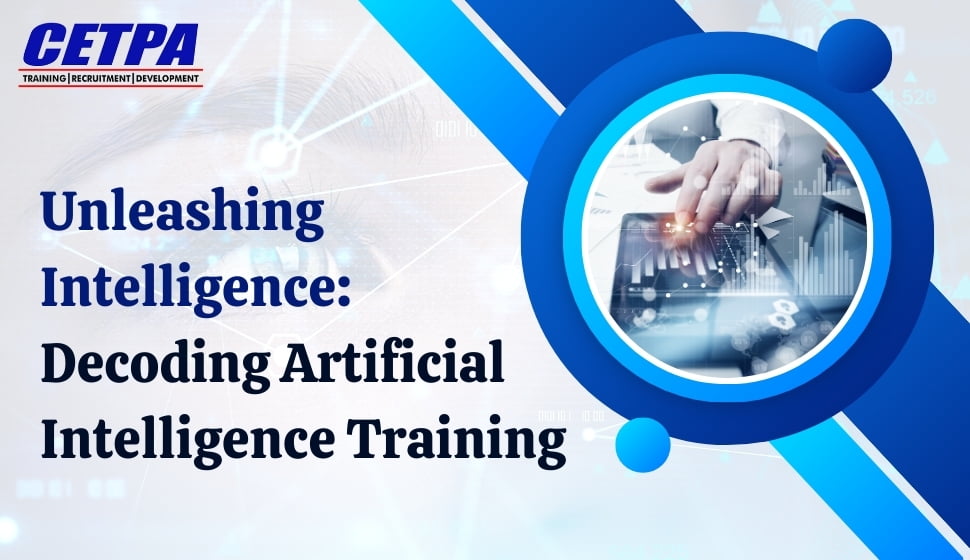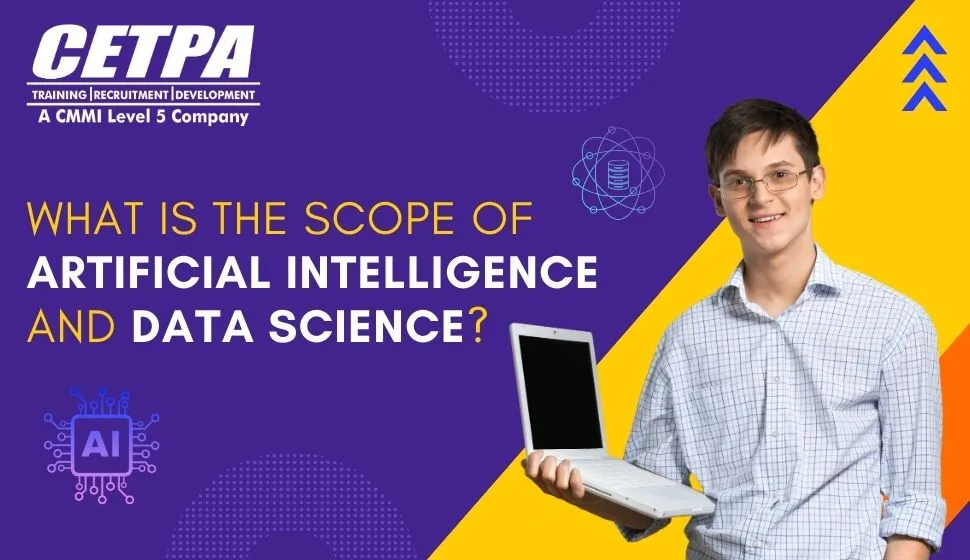Unleashing Intelligence: Decoding Artificial Intelligence Training

Artificial Intelligence is witnessing a dynamic evolution, continually expanding the possibilities of what machines can do. Central to this revolutionary trajectory is the intricate fusion of art and science known as AI training. This process encompasses exposing algorithms to large datasets, allowing them to discern patterns and make informed decisions.
From traditional machine learning to revolutionary deep learning models, AI training offered at CETPA, the Best Artificial Intelligence Training Institute serves as the crucible for honing and refining intellect. It struggles with issues including skewed datasets and the never-ending need for processing power. Cutting-edge methods such as reinforcement learning, transfer learning, and Generative Adversarial Networks (GANs) are changing the game as we explore new frontiers and push AI to previously unheard-of levels of power and sophistication.
Evolution of Artificial Intelligence Training:
The evolution of AI courses has witnessed a paradigm shift, shifting from traditional machine learning to the revolutionary domain of deep learning. Traditional machine learning marked the beginning of AI training, where algorithms were primed to make judgments or predictions using tagged datasets. This method, although efficient, faced drawbacks when confronted with complex tasks that demanded detailed knowledge of context.
The game-changing breakthrough came with the advent of deep learning. This marked a revolutionary shift, introducing neural networks characterized by multiple layers capable of learning complex patterns and representations. Unlike their predecessors, deep learning models could now explore and excel in more intricate tasks. These tasks range from image recognition to natural language processing and even game playing. The depth and complexity of these neural networks allow machines to discern subtle nuances and contextual intricacies. This further leads to the achievement of unprecedented levels of accuracy and efficiency.
However, as the AI ecosystem embraced deep learning, it also needed help with innate difficulties. The enhanced complexity of neural networks demands substantial computational power, pushing the boundaries of available resources. Moreover, the black-box nature of deep learning models introduces challenges in interpretability and explainability. Knowing how these complex neural networks arrived at specific decisions became important, specifically in areas where transparency is essential, like healthcare and finance.
In a nutshell, the rise of deep learning has undoubtedly transformed our Artificial Intelligence Training in Noida. This empowers machines to manage complex tasks with unprecedented accuracy. Yet, the challenges it poses in terms of computational demands and interpretability underline the ongoing nature of the evolutionary journey. As we face these obstacles, search for novel answers continues, moving the field toward a future in which AI systems seamlessly integrate into our daily lives, making intelligent judgments based on deep awareness of context and complexity.

Navigating The Challenges of Artificial Intelligence Training:
AI training, despite its remarkable advancements, confronts various challenges that shape the ecosystem of AI development. These challenges include:
- Data Limitations: The efficiency of AI models excessively depends on the quality and quantity of training data. In several cases, access to diverse and representative datasets is limited, resulting in biased models that may not generalize well to real-world situations.
- Compute Power: Training sophisticated AI models, specifically deep neural networks, demands substantial computational resources. The rapidly growing complexity of models demands stronger hardware and effective algorithms. Striking a balance between computational efficiency and model performance is a constant challenge as researchers find ways of optimizing training processes.
- Explainability and Interpretability: As AI models become more complex, knowing how they land at specific decisions becomes essential. This becomes more specific in high-stakes applications like healthcare or finance. The lack of interpretability raises concerns about accountability and trust.
- Adversarial Attacks: AI models are vulnerable to adversarial attacks, in which slight, intentionally placed changes to input data can result in misclassifications. Protecting AI systems against adversarial attacks is difficult, demanding robust model architectures and training strategies to improve resilience.
- Ethical Considerations: The ethical consequences of AI training are a rising concern. Biased training data can perpetuate and even increase societal prejudices, resulting in discriminatory outcomes. Guaranteeing ethical AI development encompasses addressing biases, fostering fairness, and considering the societal impact of AI applications.
Fixing these challenges demands a holistic strategy including technological innovation, ethical considerations, and interdisciplinary collaboration. As the domain of AI continues to improve, researchers strive to overcome these challenges, paving the path for robust and ethical AI systems.
For Read Also: Differentiating Between Artificial Intelligence and Machine Learning
Unleashing The Cutting-Edge Techniques in AI Training:
AI training actively evolves with cutting-edge strategies that drive innovation in the field. Various methods have come up, reshaping the ecosystem of artificial intelligence development. Some cutting-edge techniques in Artificial Intelligence training are:
- Transfer Learning: Transfer Learning encompasses using knowledge acquired from pre-trained models on one task and applying it to another. This strategy is specifically useful when labeled data for a particular task is scarce. It speeds up training and enhances performance by transferring learned characteristics from a related field.
- Reinforcement Learning: Inspired by behavioral psychology, reinforcement learning trains models via trial and error. Participants of the course learn by receiving feedback in the form of rewards or penalties based on their actions. This strategy has resulted in breakthroughs in areas like game playing, robotics, and autonomous systems.
- Generative Adversarial Networks (GANs): GANs, introduced by Ian Goodfellow, encompass two neural networks – a generator and a discriminator – trained simultaneously via adversarial processes. GANs master in generating realistic data, transforming areas like image synthesis, style transfer, and even deep fake generation.
- AutoML: AutoML streamlines the end-to-end process of applying machine learning to real-world challenges. It consists of automated model selection, hyperparameter tuning, and feature engineering. AutoML democratizes AI by making it more accessible to non-professionals and speeds up the development of efficient models.
- Meta-Learning: Meta-learning, or learning to learn, includes training models to adapt rapidly to new activities with minimal data. It concentrates on developing algorithms that can generalize across various scenarios, making AI systems more versatile and capable of rapid adaptation.
These cutting-edge techniques along with many others demonstrate the dynamic nature of AI training. It drives progress in fields such as efficiency, generalization, and adaptability. As researchers and practitioners navigate these methods, the future of AI training holds a more promising future for artificial intelligence systems.
Wrapping Up!
To conclude, the relentless pursuit of unveiling the full potential of AI advances us to explore the endless possibilities of innovative training methods. As we confront issues like data limitations, compute power constraints and ethical considerations, the adoption of cutting-edge strategies like transfer learning, reinforcement learning, and generative adversarial networks becomes essential. These methodologies not only address recent limitations but also pave the path for unprecedented levels of sophistication in AI systems.
Further, the future holds the promise of a transformative redefinition of our relationship with intelligence. With every breakthrough, we move closer to machines that not only comprehend complex tasks but also interpret and adapt to dynamic real-world situations. This evolution expands beyond just technological advancement; it involves a profound reshaping of how we perceive and integrate AI into our everyday lives. As we stand on the verge of the unknown, the ongoing journey of AI training fuels the hope that the next ground-breaking discovery will usher in an era in which AI surpasses its current capabilities, profoundly influencing industries, societies, and the human experience itself. The possibilities are infinite, and the future of AI can change the entire fabric of our intelligent interactions.
So, why wait any longer? Join our Artificial Intelligence training today and take your career to new heights!



